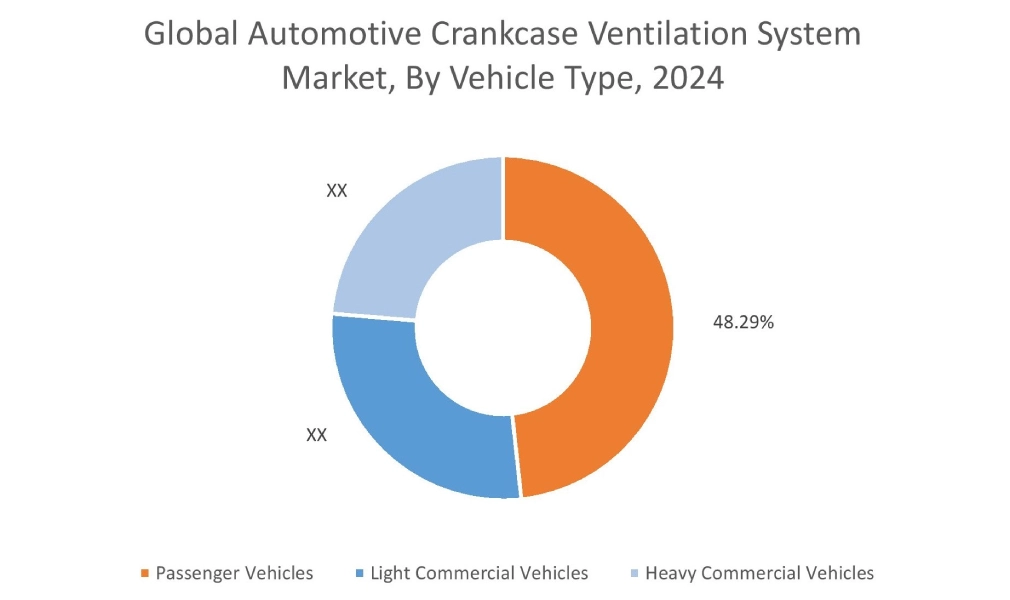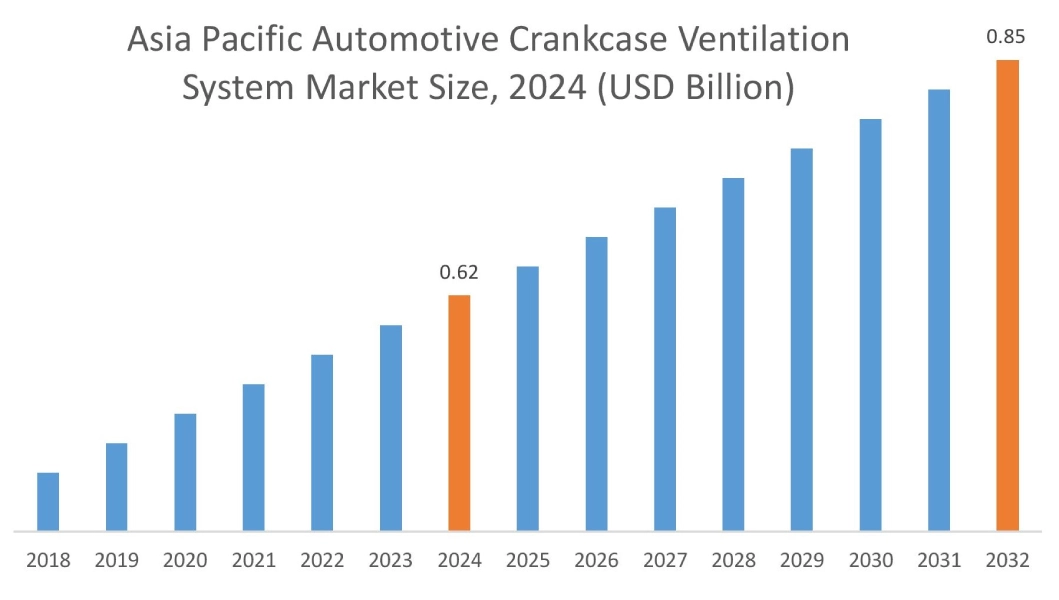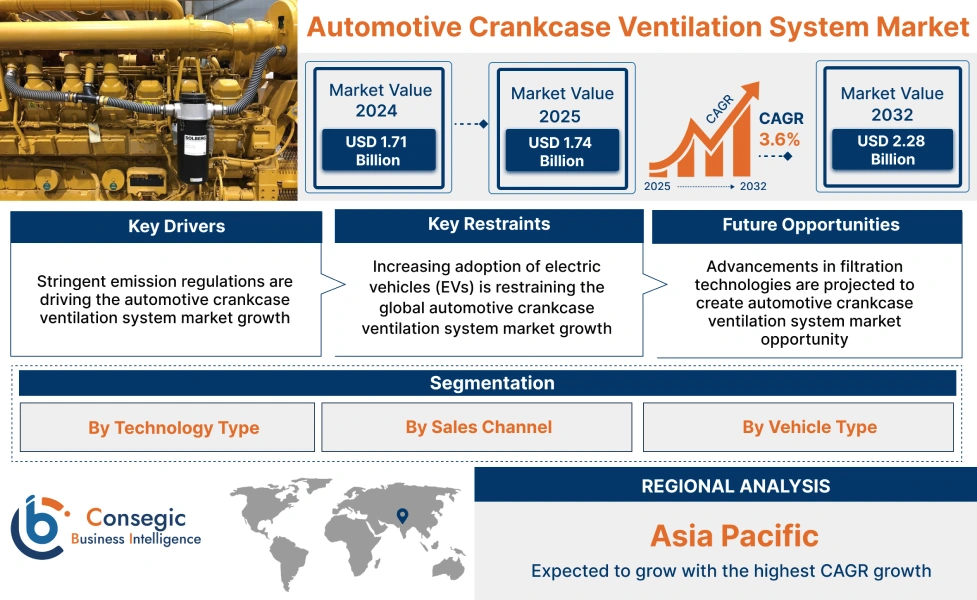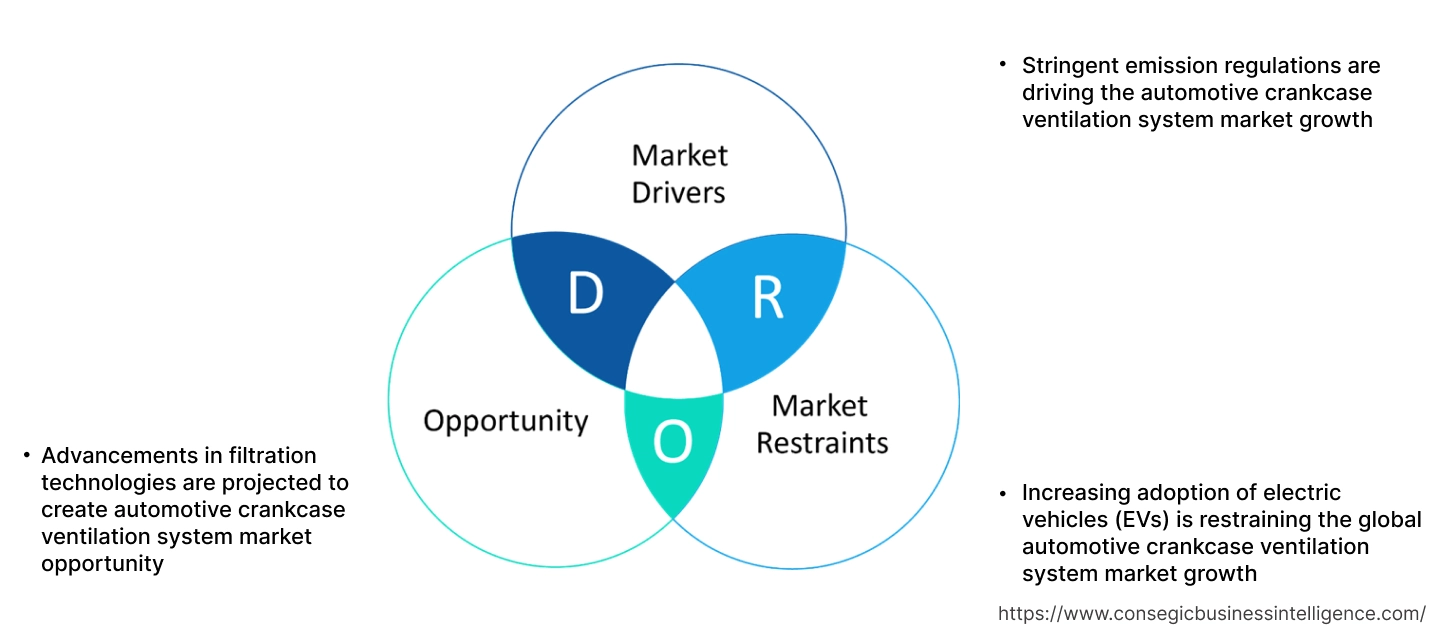Automotive Crankcase Ventilation System Market Size:
Automotive Crankcase Ventilation System Market Size is estimated to reach over USD 2.28 Billion by 2032 from a value of USD 1.71 Billion in 2024 and is projected to grow by USD 1.74 Billion in 2025, growing at a CAGR of 3.9% from 2025 to 2032.
Automotive Crankcase Ventilation System Market Scope & Overview:
The automotive crankcase ventilation system is a crucial mechanism designed to remove unwanted gases from the crankcase of an internal combustion engine. These gases, which are combustion byproducts that leak past the piston rings, contaminate the engine oil, leading to sludge formation and corrosion. The ventilation system employs a network of tubes, a one-way valve, and a vacuum source, such as the intake manifold, to extract these harmful gases. In modern vehicles, this system is a closed-loop Positive Crankcase Ventilation (PCV) system, which redirects these gases back into the engine's intake to be combusted, thereby reducing harmful emissions and improving engine longevity.
How is AI Impacting the Automotive Crankcase Ventilation System Market?
AI is impacting the automotive crankcase ventilation system (CCVS) market by enabling predictive maintenance, optimizing system performance, and enhancing overall engine efficiency. AI-driven sensor technology and real-time data analysis allow for proactive maintenance, reduced downtime, and improved emissions control. Also, AI can optimize the CCVS operation based on real-time engine conditions, such as load and speed, to ensure optimal performance and fuel efficiency. Additionally, AI is driving the integration of CCVS components with other engine systems, such as the intake manifold or valve cover, for improved efficiency and packaging. This integrated approach can reduce assembly complexity, improve sealing reliability, and lower production costs.
Automotive Crankcase Ventilation System Market Dynamics - (DRO) :
Key Drivers:
Stringent emission regulations are driving the automotive crankcase ventilation system market growth
Regulations mandate the reduction of harmful emissions from vehicles, including blow-by gases from the crankcase. Crankcase ventilation systems, particularly closed-loop PCV systems, are essential for meeting these standards by redirecting these gases back into the engine. Regulations target specific pollutants found in blow-by gases, such as hydrocarbons (HC) and particulate matter (PM). Advanced CCV systems with better oil separation and filtration capabilities are required to meet these specific reduction targets, thereby driving the automotive crankcase ventilation system market size.
- For instance, the European Union has set targets to reduce net greenhouse gas emissions by at least 55% by 2030 compared to 1990 levels and aims for climate neutrality by 2050. Regulations on new passenger cars and vans have become increasingly strict since 2020, leading to a 27% reduction in average CO2 emissions from new cars between 2019 and 2022. These regulations indirectly drive the adoption of better engine technologies, including advanced CCV systems to improve overall engine efficiency and reduce emissions.
Consequently, stringent emission regulations are driving the automotive crankcase ventilation system market expansion.
Key Restraints:
Increasing adoption of electric vehicles (EVs) is restraining the global automotive crankcase ventilation system market growth
Crankcase ventilation systems are specifically designed to manage blow-by gases produced during the combustion process in internal combustion engines (ICEs). Since EVs are powered by electric motors and batteries, they do not have this combustion process and therefore do not require crankcase ventilation systems or their components like PCV valves, hoses, and filters. Additionally, government regulations and growing consumer preferences are driving a long-term shift towards electrification of the automotive sector. Many regions have set targets to phase out the sale of new gasoline and diesel vehicles in the coming decades which poses a significant restraint to the growth of the industry.
- For instance, India's electric vehicle market experienced a 20% sales increase in 2024, with EVs comprising over 50% of 3-wheeler sales, around 5% of 2-wheeler sales, and 2% of car sales. Also, the Indian EV battery market is projected to grow significantly, from USD 16.77 billion in 2023 to USD 27.70 billion by 2028.
Therefore, as per the analysis, these combined factors are significantly hindering automotive crankcase ventilation system market share.
Future Opportunities :
Advancements in filtration technologies are projected to create automotive crankcase ventilation system market opportunity
High-efficiency coalescing filters are specifically designed to capture these sub-micron oil droplets with efficiencies often exceeding 99% for particles down to 0.3 microns. Additionally, by effectively separating and returning oil to the crankcase, these filters help reduce overall engine oil consumption, leading to lower operating costs for vehicle owners and contributing to environmental benefits by reducing the need for frequent oil top-ups. Moreover, modern gasoline direct injection (GDI) and diesel engines produce higher levels of oil mist in their blow-by gases compared to traditional port fuel injection engines. High-efficiency coalescing filters are crucial for effectively managing this increased oil load and preventing issues associated with intake valve fouling in GDI engines, hence boosting automotive crankcase ventilation system market demand.
Hence, based on the analysis, advancements in filtration technologies are expected to create automotive crankcase ventilation system market opportunities.
Automotive Crankcase Ventilation System Market Segmental Analysis :
By Technology Type:
Based on the Technology Type, the market is categorized into Open Crankcase Ventilation (OCV) and Closed Crankcase Ventilation (CCV)/Positive Crankcase Ventilation (PCV).
Trends in the Technology Type:
- Growing trend towards the adoption of CCV to redirect blow-by gases back into the engine's intake manifold to be combusted, significantly reducing harmful emissions.
- OCV systems are mostly limited to older vehicles or specific off-highway applications where emission regulations are less stringent.
Closed Crankcase Ventilation (CCV)/Positive Crankcase Ventilation (PCV) accounted for the largest revenue share in 2024 and is also projected to witness the fastest CAGR.
- PCV systems integrate sensors and electronic control units (ECUs), which allow for dynamic adjustment of the PCV valve operation based on engine load and conditions, hence driving the automotive crankcase ventilation system market share.
- Trend towards integrating the PCV system with other engine components, such as the intake manifold or valve cover, for improved efficiency and packaging.
- Electrically assisted PCV systems are emerging to ensure proper crankcase ventilation under positive intake pressure conditions, further boosting the automotive crankcase ventilation system market trend.
- For instance, Caterpillar introduced its Cat CCV System for G3600 engines, an affordable and easily installed solution that can cut methane emissions by as much as 20%, aiding in the achievement of climate goals. This system also streamlines regulatory compliance by removing the necessity for users to measure, track, and report crankcase emissions.
- Thus, as per the automotive crankcase ventilation system market analysis, the aforementioned factors are driving the Closed Crankcase Ventilation (CCV)/Positive Crankcase Ventilation (PCV) segment growth.
By Sales Channel:
Based on the Sales Channel, the market is classified into Original Equipment Manufacturer (OEM) and Aftermarket.
Trends in the Sales Channel:
- OEMs are demanding more integrated CCV systems, tailored to specific engine designs and emission control strategies.
- Large existing fleet of internal combustion engine vehicles drives the need for replacement CCV components in the aftermarket.
Original Equipment Manufacturer (OEM) accounted for the largest revenue in 2024.
- Trend toward the adoption of advanced filtration and separation technologies in OEM-supplied systems to meet stringent emission regulations is driving the automotive crankcase ventilation system market demand.
- OEMs are pushing for lighter and more compact CCV system designs to contribute to vehicle fuel efficiency and packaging optimization.
- Thus, as per the automotive crankcase ventilation system market analysis, the aforementioned factors are contributing significantly to driving the industry size.
Aftermarket is predicted to register the fastest CAGR during the forecast period.
- Growing trend towards online sales of automotive parts, including CCV components, is increasing due to convenience and wider product availability is reshaping the traditional distribution channels.
- Vehicle owners are seeking high-quality and durable replacement CCV components to ensure optimal engine performance and compliance with emission standards.
- Further, the increasing average age of vehicles on the road is a key driver for the aftermarket, as older vehicles require more frequent maintenance and replacement of components.
- Subsequently, as per the market analysis, the aforementioned factors are collectively responsible for accelerating the industry growth during the forecast period.
By Vehicle Type:
Based on the vehicle type, the market is categorized into passenger vehicles, light commercial vehicles, and heavy commercial vehicles.
Trends in the Vehicle Type:
- Heavy Commercial Vehicles (HCVs) with large, powerful engines require heavy-duty CCV systems capable of managing significant volumes of blow-by gases.
- HCVs face stringent regulations regarding nitrogen oxides (NOx) and particulate matter emissions, driving the adoption of advanced CCV technologies.
Passenger Vehicles accounted for the largest revenue share of 48.29% in 2024.
- Stricter emission standards like Euro 6 and Bharat Stage VI are driving the adoption of more efficient crankcase ventilation systems to minimize hydrocarbon emissions.
- Consumers' preference for fuel-efficient vehicles is compelling manufacturers to integrate advanced CCV systems that optimize engine performance and reduce fuel consumption.
- Rising need for smaller and lighter CCV systems to align with the trend of vehicle weight reduction for improved fuel economy.
- For instance, the Indian passenger car market is projected to grow at over 9% annually from USD 32.70 billion in 2021 to USD 54.84 billion by 2027.
- In conclusion, the aforementioned factors are contributing to the growth of the global automotive crankcase ventilation system market size.
Light Commercial Vehicles is predicted to register the fastest CAGR during the forecast period.
- For LCVs used in demanding logistics and delivery services, the focus is on robust and reliable CCV systems that can withstand heavy-duty operations and ensure engine longevity.
- Crankcase ventilation systems in LCVs are designed to maintain optimal engine performance under various load conditions, ensuring efficiency and reducing downtime.
- Additionally, the surge in e-commerce and last-mile delivery services is driving the production of LCVs, thereby driving the automotive crankcase ventilation system market trend.
- Subsequently, as per the market analysis, the aforementioned factors are collectively responsible for accelerating the market growth during the forecast period.

Regional Analysis:
The global automotive crankcase ventilation system market has been classified by region into North America, Europe, Asia-Pacific, Middle East & Africa, and Latin America.

Asia Pacific was valued at USD 0.62 Billion in 2024. Moreover, it is projected to grow by USD 0.64 Billion in 2025 and reach over USD 0.85 Billion by 2032. Out of these, the China accounted for the largest revenue share of 33.05% in 2024. Asia Pacific is the world's largest automotive production and sales hub, with countries like China, India, Japan, and South Korea being major contributors. The continuous increase in vehicle ownership, driven by rising disposable incomes and urbanization, directly translates to a higher demand for automotive components, including crankcase ventilation systems.

North America region was valued at USD 0.41 Billion in 2024. Moreover, it is projected to grow by USD 0.42 Billion in 2025 and reach over USD 0.55 Billion by 2032. Crankcase ventilation systems are specifically designed to manage and reduce hydrocarbon emissions, which are unburnt fuel vapors that escape from the engine's crankcase. Regulatory bodies like the Environmental Protection Agency (EPA) at the federal level and the California Air Resources Board (CARB) at the state level have set increasingly stringent limits on these emissions.
- For instance, in July 2023, CARB and truck/engine manufacturers partnered together. CARB will align its nitrogen oxide (NOx) regulations with the EPA's 2027 standards. While CARB will modify some aspects of its 2024 NOx rules, manufacturers will compensate to ensure California's emission reduction goals are met. Importantly, CARB has committed to providing at least four years of lead time and three years of regulatory stability before introducing any new requirements.
As per market analysis, stringent Euro emission standards and a strong push towards electrification are driving demand for advanced and efficient crankcase ventilation systems. Additionally, growing vehicle production and gradually tightening emission regulations are creating increasing demand for crankcase ventilation systems in Latin American countries. Further, increasing vehicle ownership and a slow but steady move towards stricter emission standards are contributing to a growing market for crankcase ventilation systems in Middle East and Africa.
Top Key Players and Market Share Insights:
The market is highly competitive with major players providing automotive crankcase ventilation systems to the national and international markets. Key players are adopting several strategies in research and development (R&D), product innovation, and end-user launches to hold a strong position in the market. Key players in the automotive crankcase ventilation system industry include-
- MANN+HUMMEL (Germany)
- MAHLE GmbH (Germany)
- Sogefi Group (Italy)
- Toyota Boshoku Corporation (Japan)
- Aisan Industry Co. Ltd. (Japan)
- Wells Vehicle Electronics (USA)
- Hengst SE (Germany)
- Parker Hannifin Corp. (USA)
- Donaldson Company, Inc. (USA)
- Cummins Inc. (USA)
- Alfdex AB (Sweden)
- ElringKlinger AG (Germany)
Recent Industry Developments :
Product Launch:
- In Oct 2024, Caterpillar Oil & Gas introduced its Cat Closed Crankcase Ventilation (CCV) System, a new technology that prevents blow-by emissions from gas-powered engines. This engine-mounted system helps gas compression operators cost-effectively meet environmental regulations while continuing to use their existing equipment.
Expansion:
- In Nov 2023, Hengst Filtration extended its aftermarket offerings to include OEM-quality transmission oil pans and Crankcase Ventilation systems. Leveraging their existing expertise as a supplier to original equipment manufacturers, Hengst aims to provide high-quality options in these new product areas for the independent aftermarket.
Automotive Crankcase Ventilation System Market Report Insights :
| Report Attributes | Report Details |
| Study Timeline | 2019-2032 |
| Market Size in 2032 | USD 2.28 Billion |
| CAGR (2025-2032) | 3.9% |
| By Technology Type |
|
| By Sales Channel |
|
| By Vehicle Type |
|
| By Region |
|
| Key Players |
|
| North America | U.S. Canada Mexico |
| Europe | U.K. Germany France Spain Italy Russia Benelux Rest of Europe |
| APAC | China South Korea Japan India Australia ASEAN Rest of Asia-Pacific |
| Middle East and Africa | GCC Turkey South Africa Rest of MEA |
| LATAM | Brazil Argentina Chile Rest of LATAM |
| Report Coverage |
|
Key Questions Answered in the Report
How big is the automotive crankcase ventilation system market? +
The automotive crankcase ventilation system market size is estimated to reach over USD 2.28 Billion by 2032 from a value of USD 1.71 Billion in 2024 and is projected to grow by USD 1.74 Billion in 2025, growing at a CAGR of 3.9% from 2025 to 2032.
What specific segmentation details are covered in the automotive crankcase ventilation system report? +
The automotive crankcase ventilation system report includes specific segmentation details for technology type, sales channel, vehicle type, and regions.
Which is the fastest segment anticipated to impact the market growth? +
In the automotive crankcase ventilation system market, aftermarket is the fastest-growing segment during the forecast period.
Who are the major players in the automotive crankcase ventilation system market? +
The key participants in the automotive crankcase ventilation system market are MANN+HUMMEL (Germany), MAHLE GmbH (Germany), Hengst SE (Germany), Parker Hannifin Corp. (USA), Donaldson Company, Inc. (USA), Cummins Inc. (USA), Alfdex AB (Sweden), ElringKlinger AG (Germany), Sogefi Group (Italy), Toyota Boshoku Corporation (Japan), Aisan Industry Co. Ltd. (Japan), Wells Vehicle Electronics (USA), and Others.


